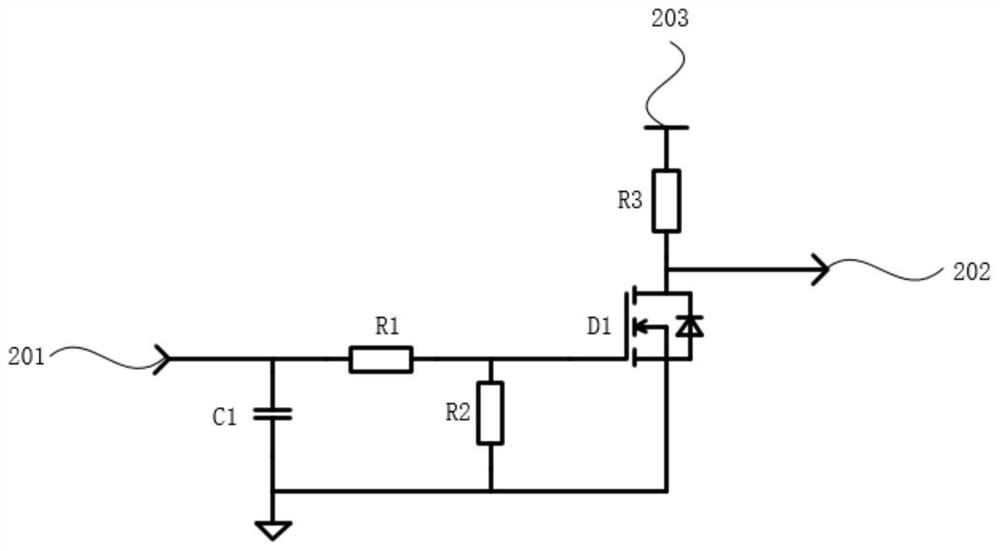Active short-circuit signal processing circuit and vehicle
A signal processing circuit, active short-circuit technology, applied in electric vehicles, vehicle components, vehicle energy storage and other directions, can solve problems such as the inability to achieve active short-circuit, the inability of the IGBT driver chip to output control signals, and the inability to guarantee the IGBT driver chip. The effect of slowing down and avoiding accidents
- Summary
- Abstract
- Description
- Claims
- Application Information
AI Technical Summary
Problems solved by technology
Method used
Image
Examples
Embodiment 1
[0051] figure 1 The schematic diagram of the functional module of the active short-circuit signal processing circuit provided by Embodiment 1 of the present invention, this embodiment can be applied to the normal or abnormal operation of the low-voltage domain, refer to figure 1, the active short circuit signal processing circuit includes: an optocoupler drive circuit 101, a high and low voltage isolation circuit 102, a filter circuit 103, a diagnostic circuit 104, and a drive circuit 105;
[0052] The optocoupler drive circuit 101 includes an input terminal, an output terminal, and a power supply terminal. The input terminal of the optocoupler drive circuit 101 is connected to the active short-circuit signal 201 output from the low-voltage domain, and the power supply terminal of the optocoupler drive circuit 101 is connected to the logic power supply voltage of the low-voltage domain;
[0053] The high and low voltage isolation circuit 102 includes an input terminal, an outp...
Embodiment 2
[0059] On the basis of the above examples, refer to figure 2 , figure 2 It is a schematic diagram of an optocoupler driving circuit provided in Embodiment 2 of the present invention. The optocoupler driving circuit 101 includes a first resistor R1, a second resistor R2, a third resistor R3, a first capacitor C1 and a first MOS transistor D1; A resistor R1 is connected between the input terminal of the optocoupler drive circuit 101 and the gate of the first MOS transistor D1; the second resistor R2 is connected between the gate of the first MOS transistor D1 and the first pole; the first capacitor C1 The first pole of the first capacitor C1 is connected to the first terminal of the first resistor R1, the second pole of the first capacitor C1 is connected to the first ground terminal; the first pole of the first MOS transistor D1 is connected to the first ground terminal, and the second pole of the first MOS transistor D1 The two poles are connected to the output terminal of ...
Embodiment 3
[0087] A vehicle comprising the active short-circuit signal processing circuit described in any embodiment of the present invention.
[0088] The main idea of the present invention is to transmit the PWM-type active short-circuit signal 201 representing the normal operation of the low-voltage domain control module through the devices in the high-voltage and low-voltage isolation circuit 102, and adjust it through the filter circuit 103 into a signal that can be used for diagnosis by the diagnostic circuit 104. The diagnosis result 207 is adjusted into a driving signal through the driving circuit 105, which facilitates driving control. For high and low voltage isolation processing, the active short circuit signal 201 in the low voltage domain can directly act on the high voltage domain after the signal processing of the present invention. It is not affected by low-voltage power supply and has higher safety. The circuit involved in the present invention is a pure hardware cir...
PUM
 Login to View More
Login to View More Abstract
Description
Claims
Application Information
 Login to View More
Login to View More - R&D
- Intellectual Property
- Life Sciences
- Materials
- Tech Scout
- Unparalleled Data Quality
- Higher Quality Content
- 60% Fewer Hallucinations
Browse by: Latest US Patents, China's latest patents, Technical Efficacy Thesaurus, Application Domain, Technology Topic, Popular Technical Reports.
© 2025 PatSnap. All rights reserved.Legal|Privacy policy|Modern Slavery Act Transparency Statement|Sitemap|About US| Contact US: help@patsnap.com



